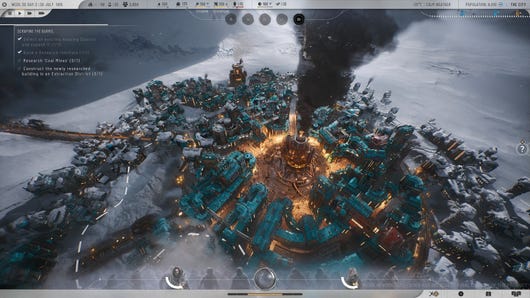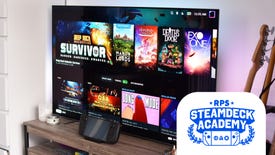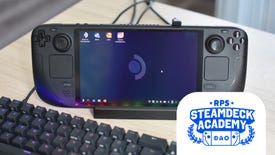-

Still plenty of ways to make children miserable, though
-

Fallout 4, New Vegas and 76 have more than doubled their players on Steam
-

Review: Goblin Stone review: turn-based charm spells only last so long
Goblin’ up my patience more like
-

Katharine is leaving RPS, come say goodbye
And thank you for all the words
-

Pool Of Madness is pool by way of Lovecraft
I can only imagine someone said ‘Cue-thulhu’ by mistake and took it from there
-

Screenshot Saturday Mondays: Flintlocks and chainsaw bayonets
I go on Twitter so you don't have to
-

LawBreakers is staging an unofficial comeback, five years after it (and its makers) shut down
The gravity-defying debut FPS from Cliff Bleszinski's studio
-
Final Fantasy 14's Dawntrail benchmarking tool has players happy with its new playable catmoms
Teeth remain an issue for some
-
Supporters only: An action platformer about getting an eye back from ants affirms my belief that games need a Ronseal approach to their titles
Ants Took My Eyeball is about a man who has had his eyeball taken. By ants.
-
The Maw - 15th-20th April 2024
This week's least boring videogame releases, plus our weekly liveblog
Live
Psst! Explore our new "For you" section and get personalised recommendations about what to read.
-

You can get a WD Black SN850X 2TB SSD for as little as £112 but they're selling fast
Save up to £28 on this speedy SSD using the eBay app and a special discount code.
-

The Crucial P3 2TB, one of the fastest 3.0 SSDs, is on sale for just £85
Get a big chunk of storage space for a bargain price.
-

Pay $88 for this mammoth 1.5TB SanDisk Ultra Micro SD card
That's less than six cents per gigabyte.
-
My favourite PC case, the NZXT H5 Flow, is 21% off in the Amazon Spring sale
Go with the Flow for just £71
-

Over 100 staff at Just Cause developers Avalanche have unionised
Agreement will take effect from this time next year
-

“I know $70 is already a lot, but it's an option at the end of the game I wish I had at times. Some games are that special”
-

More entities due in future updates as developer shifts away from adding endgame content
-

“The past four years of our work stand to just simply break”
-

LawBreakers is staging an unofficial comeback, five years after it (and its makers) shut down
The gravity-defying debut FPS from Cliff Bleszinski's studio
-

Final Fantasy 14's Dawntrail benchmarking tool has players happy with its new playable catmoms
Teeth remain an issue for some
-
Fallout 4, New Vegas and 76 have more than doubled their players on Steam
-
Pool Of Madness is pool by way of Lovecraft
I can only imagine someone said ‘Cue-thulhu’ by mistake and took it from there
-
Katharine is leaving RPS, come say goodbye
And thank you for all the words
-
The Maw - 15th-20th April 2024
This week's least boring videogame releases, plus our weekly liveblog
Live
-

Supporters only: An action platformer about getting an eye back from ants affirms my belief that games need a Ronseal approach to their titles
Ants Took My Eyeball is about a man who has had his eyeball taken. By ants.
I sometimes struggle with what to write about for supporter posts (a contender this week was "why does Fallout the TV show insist Walton Goggins' character is from California when he talks like Foghorn Leghorn?"). And then we got an email about a game called Ants Took My Eyeball and I was like "Man, games need good names more often." I played the Steam demo …
-

Supporters only: Carpathian Night Starring Bela Lugosi takes Castlevania back to basics
And they call it Bela Notmuche
-
Supporters only: Fantasy games have a weird relationship with regional British accents
Whose epaulet is that pauldron?
-
Supporters only: I am obsessed with this detailed but very weird aquarium sim
Right click to throw away
Get your first month for £1 (normally £3.99) when you buy a Standard Rock Paper Shotgun subscription. Enjoy ad-free browsing, our monthly letter from the editor, and discounts on RPS merch. Your support helps us create more great writing about PC games.
See more information-

Review: Goblin Stone review: turn-based charm spells only last so long
Goblin’ up my patience more like
-

Review: Bore Blasters review: achieve catharsis as a dwarf yelling and shooting mud
Explodey hole
-

Review: Broken Roads review: this Fallout-style RPG is Vegemite and (some) magic
Dollarydoo or dollarydon’t?
-

Review: Children Of The Sun review: an intense and stylish puzzle of ultraviolence
The only option is shoot to kill
-

A very puzzling collection
-

The 15 best open world games on PC
Keep your options open
-

Review: Botany Manor review: peaceful and beautiful best-in-show plant puzzles
Come away, O human child! To the waters and the wild
-

From older classics to brand new trail-blazers
-

Manor Lords’ early access launch is built on solid technical ground, mostly
Mind your manors with this performance and settings guide
-

How to connect a Steam Deck to a TV
It's not quite plug and play
-

Best SSD for gaming: our top SATA and NVMe picks
Our top solid state drive recommendations
-

Give your Steam Deck some mouse 'n' keyboard comfort with the best docks we’ve tested
-

Pool Of Madness is pool by way of Lovecraft
I can only imagine someone said ‘Cue-thulhu’ by mistake and took it from there
-

Screenshot Saturday Mondays: Flintlocks and chainsaw bayonets
I go on Twitter so you don't have to
-

Supporters only: Carpathian Night Starring Bela Lugosi takes Castlevania back to basics
And they call it Bela Notmuche
-

Visit a mystical Montreal corner shop in this lovely little indie game
It's taken me four years to post Dépanneur Nocturne but it's still great
-

Over 100 staff at Just Cause developers Avalanche have unionised
Agreement will take effect from this time next year
-

“I know $70 is already a lot, but it's an option at the end of the game I wish I had at times. Some games are that special”
-

More entities due in future updates as developer shifts away from adding endgame content
-

“The past four years of our work stand to just simply break”
-

Still plenty of ways to make children miserable, though
-

LawBreakers is staging an unofficial comeback, five years after it (and its makers) shut down
The gravity-defying debut FPS from Cliff Bleszinski's studio
-
Final Fantasy 14's Dawntrail benchmarking tool has players happy with its new playable catmoms
Teeth remain an issue for some
-
Fallout 4, New Vegas and 76 have more than doubled their players on Steam
-
Pool Of Madness is pool by way of Lovecraft
I can only imagine someone said ‘Cue-thulhu’ by mistake and took it from there
-
Supporters only: An action platformer about getting an eye back from ants affirms my belief that games need a Ronseal approach to their titles
Ants Took My Eyeball is about a man who has had his eyeball taken. By ants.
-

Wordle hint and answer today #1032 (April 16 2024)
Stuck on today's Wordle word for April 16? Read our hint or find the answer below!
-

Today's NYT Connections hint and answers (Tue, Apr 16)
Need a hint for today's Connections? Read our guide for help with Connections #310
-

Slayers Unleashed codes [April 2024]
Unleash your inner demon-slayer with these powerful freebie codes
-

All Star Tower Defense codes list [April 2024]
A list of all All Star Tower Defense codes
-

Whether cop or robber, you'll benefit from the freebies these codes get you
-

Tiny Tina's Wonderlands SHiFT codes
Grab yourself some premium loot with these new SHiFT codes for Tiny Tina's Wonderlands!
-
Anime Dimensions codes [April 2024]
Redeem these codes for free gems and boosts!
-
World Of Stands codes [April 2024]
Power up your Stand abilities with the goodies these codes bring
-
Here's an archive of previous Wordle words
-
Wordle hint and answer #1031 (April 15 2024)
Stuck on today's Wordle word for April 15? Read our hint or find the answer below!









3